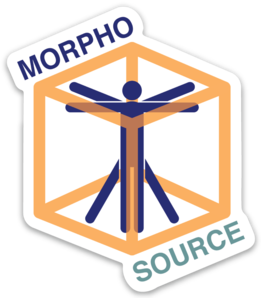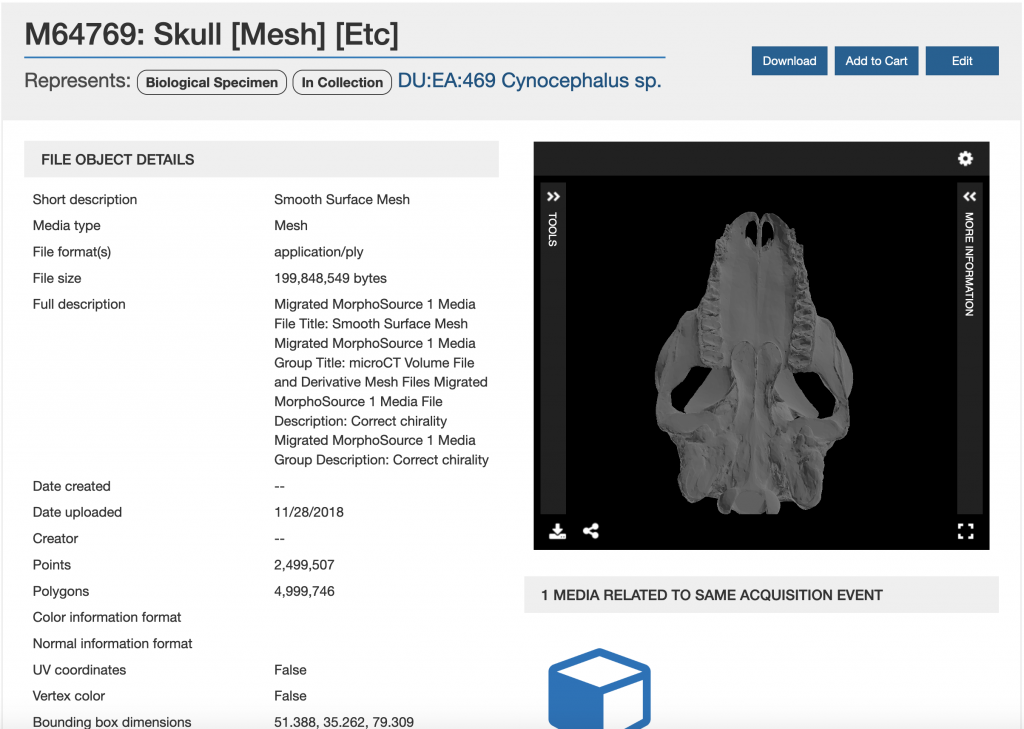 Header Image: Collection of extinct and extant turtle skull microCT scans in MorphoSource: bit.ly/3DFossilTurtles
Header Image: Collection of extinct and extant turtle skull microCT scans in MorphoSource: bit.ly/3DFossilTurtles
MorphoSource (www.morphosource.org) is a publicly accessible repository for 3D research data, especially data that represents biological specimens. Developers in Evolutionary Anthropology and the Library’s Software Services department have been working to rebuild the application, improving upon the current site’s technology and features. An important part of this rebuild is implementing a more robust data model that will let our users efficiently discover, curate, disseminate, and preserve their data.
A typical deposit in MorphoSource is a file or files that represent a scan of all or part of an organism – such as a bone, tooth, or entire animal. The files may be a mesh or series of images produced through a CT scan. In order to collect all the information necessary to understand the files, the specimen that the files represent, and the processes that created the data, the improved site will guide the researcher in providing additional context for their deposit at the same time that they upload their files. The following describes what kind of metadata the depositor can expect to provide as part of the submission process.
The first step is to determine whether the researcher’s current deposit is derived in some way from data that is already in MorphoSource, or if the depositor would like to also submit those files and metadata. For example, they may be depositing a mesh file that was created from original photographs that are already available through the site. By including links to the raw data in the repository, users can reprocess the files if needed, or run different processes in the future.

Next, the researcher is asked to identify or describe the biological specimen that was imaged to create their data, either by entering the information themselves or importing it from another site like iDigBio. Metadata entered at this stage includes the information about the institution that owns the specimen, a taxonomy for the specimen, and additional identifying information such as the institution’s collection or catalog number. When the depositor fills in these fields, other users will be able to search for and compare data sets for the same specimen or species.
Moving on from the description of the organism, the depositor then provides information about the device that was used to image the specimen, either by selecting a device that is already in the repository’s database, or by creating a new record, including the manufacturer, model, and modality (MRI, photography, laser scan, etc.) of the device.
Once they have described the specimen and device used for imaging, the depositor then enters metadata about the imaging event itself, such as the technician who did the imaging, the date, and the software used.
With the imaging of the specimen described, the depositor then enters data about any processing that was done to create the files being deposited, including who was responsible, what software was used, and what the process was – for example, creating a mesh or point cloud from photographs. This metadata is important in case there is a need to reprocess the data in the future.
Finally, the researcher completes their deposit by uploading the files themselves. While some technical metadata is extracted automatically, MorphoSource will rely on data depositors to provide other information that is helpful for display, such as the orientation of the scan, or to identify the files, like an external id number. This technical metadata is important for long term preservation of the data sets.

While the submission process asks the researcher to enter quite a bit of metadata, when users view the data on MorphoSource they have an understanding of what the data represents, how it was created, and how it relates to other data in the repository. It becomes easy to discover other media files representing the same specimen, or the same species, or to explore other items from the institution or researcher’s collections.


